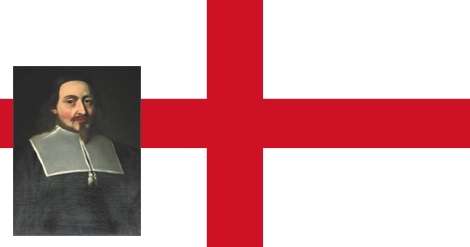In 1634, John Endecott and Roger Williams agreed on one thing. The first Massachusetts flag had to be changed.
Endecott, of Salem, was one of the more radical of the early Puritan settlers of Massachusetts. He lost some of his power when John Winthrop arrived from London with a colonial charter.
 Winthrop became governor and Endecott became a councilor.
Winthrop became governor and Endecott became a councilor.
John Endecott Removes the Cross
Part of the flag carried a red St. George’s cross on a white background. But the design offended the Puritan sensibilities of Massachusetts colonists. They felt the red cross had roots in Catholicism. And, at the time, they had questions about King Charles I’s Catholic leanings.
Under goading from the religious radical Roger Williams, soon facing banishment to Rhode Island, John Endecott had the red cross removed from the flag that flew at Salem. The public supported Endecott’s actions. But he was well ahead of his time, a fact that worried the more politically astute members of the colony.
Nearly 10 years would pass before Civil War broke out in England and the English people would gleefully strip the red cross from public symbols. And so the Massachusetts Court of Assistants called on Endecott to answer for his actions.
John Winthrop noted the matter in his journal: “At the court of assistant complaint was made by some of the country that the ensign at Salem was defaced viz: one part of the red cross was taken out… Much matter was made of this fearing it would be taken as a an act of rebellion.”
Massachusetts’ leaders worried that the defacing of the flag would cause trouble in England if the government took offense. They wrote a letter to the colony’s lawyer in London, John Winthrop’s brother-in-law Emanuel Downing. In it they relayed the details of what had happened and noted that they would punish the perpetrators.
Winthrop hoped the letter would quell any anger if the public learned of flag defacing.
Vindication
But the letter wasn’t exactly true. When the Court of Assistants met in January of 1635, feeling against the red cross symbol ran high and the court couldn’t agree about what to do.
In May of 1685, a court was appointed to review Endecott’s actions and it censured him. The court didn’t declare that Endecott was wrong in his reasoning. that indeed the cross was a sign of Catholic beliefs and should be removed from the flag. But Endecott had overstepped his authority.
Winthrop noted: “They found his offense to be great, rash and without discretion, taking on more authority than he had.”
But the court magistrates also noted part of the problem: Endecott had not consulted the general court in his actions. That meant the colony could not have considered altering all the flags. The result gave the appearance, they concluded, that others in Massachusetts supported idolatry in contrast to Salem.
Endecott was banned from leadership positions for a year as a censure, a fairly mild slap on the wrist. But as political opinion in England caught up with Endecott, he rose through the ranks of government. Shortly after the English Civil War broke out, Endecott won appointment as governor of Massachusetts.
Thanks to: How John Endecott Cut the Red Cross from the Flag by Nathan Hawkes. This story last updated in 2022.